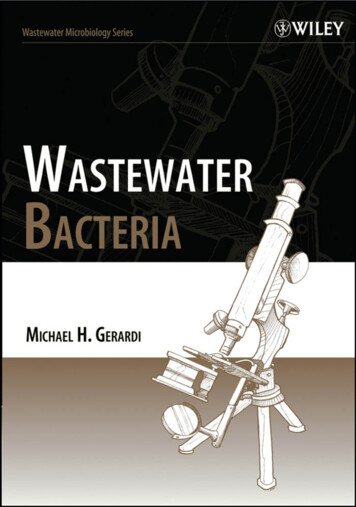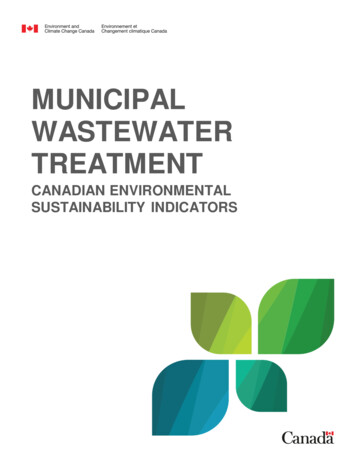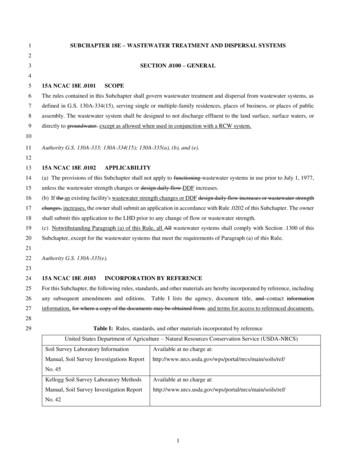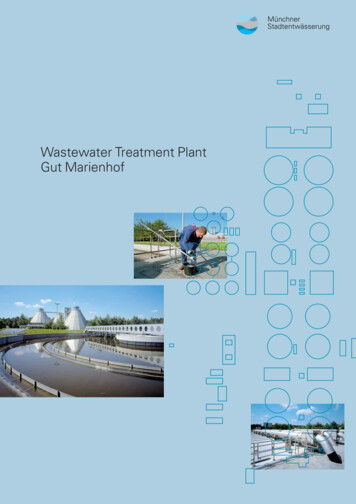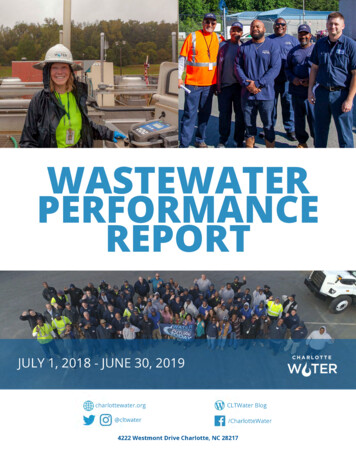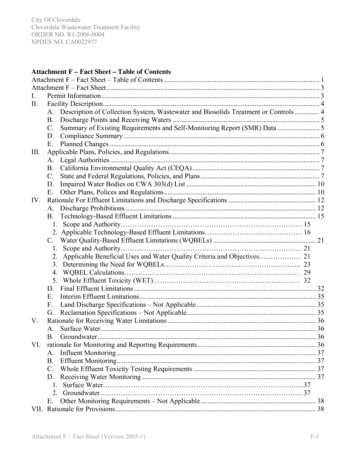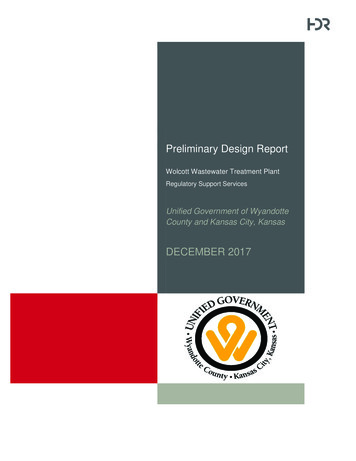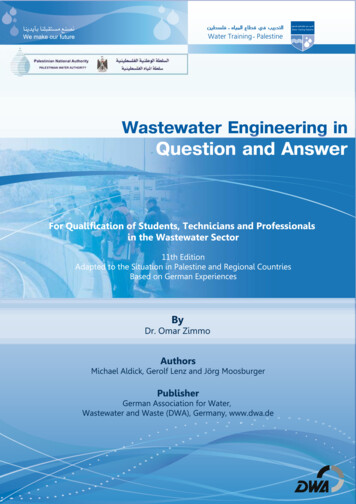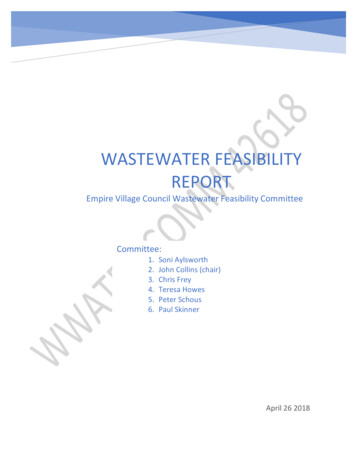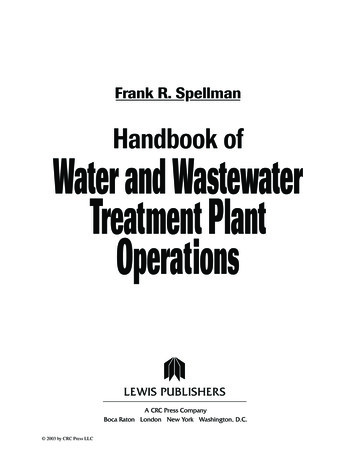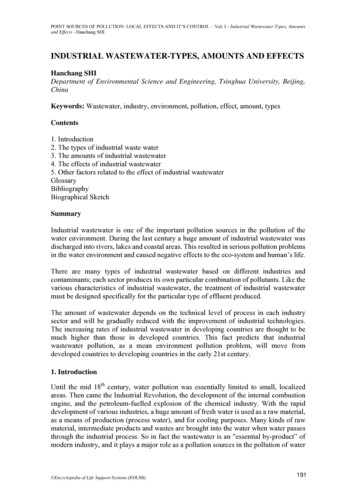
Transcription
Wastewater Treatment:Overview and BackgroundClaudia CopelandSpecialist in Resources and Environmental PolicyOctober 30, 2014Congressional Research Service7-5700www.crs.gov98-323
Wastewater Treatment: Overview and BackgroundSummaryThe Clean Water Act prescribes performance levels to be attained by municipal sewage treatmentplants in order to prevent the discharge of harmful wastes into surface waters. The act alsoprovides financial assistance so that communities can construct treatment facilities to complywith the law. The availability of funding for this purpose continues to be a major concern of statesand local governments.This report provides background on municipal wastewater treatment issues, federal treatmentrequirements and funding, and recent legislative activity. Meeting the nation’s wastewaterinfrastructure needs efficiently and effectively is likely to remain an issue of considerable interestto policymakers.Congressional Research Service
Wastewater Treatment: Overview and BackgroundContentsIntroduction. 1Federal Aid for Wastewater Treatment . 1How the SRF Works . 2Other Federal Assistance . 3How Localities Pay for Construction Costs . 4Water Quality Improvements. 4Remaining Needs. 5Legislative Activity . 6TablesTable 1. CWA Wastewater Treatment Funding . 2ContactsAuthor Contact Information. 7Congressional Research Service
Wastewater Treatment: Overview and BackgroundIntroductionWaste discharges from municipal sewage treatment plants into rivers and streams, lakes, andestuaries and coastal waters are a significant source of water quality problems throughout thecountry. States report that municipal discharges are the second leading source of water qualityimpairment in all of the nation’s waters. Pollutants associated with municipal discharges includenutrients (which can stimulate growth of algae that deplete dissolved oxygen, a process thatharms aquatic ecosystems, since most fish and other aquatic organisms “breathe” oxygendissolved in the water column), bacteria and other pathogens (which may impair drinking watersupplies and recreation uses), and metals and toxic chemicals from industrial and commercialactivities and households.The Clean Water Act (CWA) prescribes performance levels to be attained by municipal sewagetreatment plants in order to prevent the discharge of harmful quantities of waste into surfacewaters, and to ensure that residual sewage sludge meets environmental quality standards. Itrequires secondary treatment of sewage (equivalent to removing 85% of raw wastes), or treatmentmore stringent than secondary where needed to achieve water quality standards necessary forrecreational and other uses of a river, stream, or lake.Federal Aid for Wastewater TreatmentIn addition to prescribing municipal treatment requirements, the CWA authorizes the principalfederal program to aid wastewater treatment plant construction. Congress established thisprogram in the Federal Water Pollution Control Act Amendments of 1972 (P.L. 92-500),significantly enhancing what previously had been a modest grant program. Since then, Congresshas appropriated more than 89 billion to assist cities in complying with the act and achieving theoverall objectives of the act: restoring and maintaining the chemical, physical, and biologicalintegrity of the nation’s waters (see Table 1).Title II of P.L. 92-500 authorized grants to states for wastewater treatment plant constructionunder a program administered by the Environmental Protection Agency (EPA). Federal funds areprovided through annual appropriations under a state-by-state allocation formula contained in theact; the formula (which has been modified several times since 1972) is based on states’ financialneeds for treatment plant construction and population. States used their allotments to make grantsto cities to build or upgrade categories of wastewater treatment projects including treatmentplants, related interceptor sewers, correction of infiltration/inflow of sewer lines, and sewerrehabilitation.Amendments enacted in 1987 (P.L. 100-4) initiated a new program to support, or capitalize, StateWater Pollution Control Revolving Funds (SRFs). States continue to receive federal grants, butnow they provide a 20% match and use the combined funds to make loans to communities.Monies used for construction are repaid to states to create a “revolving” source of assistance forother communities. The SRF program replaced the previous Title II program in FY1991. Federalcontributions to SRFs were intended to assist a transition to full state and local financing byFY1995; SRFs were to be sustained through repayment of loans made from the fund after thatdate. The intention was that states would have greater flexibility to set priorities and administerfunding in exchange for an end to federal aid after 1994, when the original CWA authorizationsexpired. However, although most states believe that the SRF is working well today, early fundingCongressional Research Service1
Wastewater Treatment: Overview and Backgroundand administrative problems, plus remaining funding needs (discussed below), delayed theanticipated shift to full state responsibility. Congress has continued to appropriate funds to assistwastewater construction activities, as shown in Table 1. (This table excludes appropriations forcongressionally earmarked water infrastructure grants in individual communities and regions,which totaled 7.5 billion from FY1989 through FY2013.)Table 1. CWA Wastewater Treatment Funding( in millions)Fiscal aTotal66,58090,859Source: Budget of the United States Government, Appendix, various years; compiled by CRS.a.Total includes 4.0 billion in supplemental FY2009 appropriations under the American Recovery andReinvestment Act (P.L.11-5).How the SRF WorksWhen the SRF program was created, it represented a major shift in how the nation financeswastewater treatment needs. In contrast to the Title II construction grants program, whichprovided grants directly to localities, SRFs are loan programs. States use their SRFs to provideseveral types of loan assistance to communities, including project construction loans made at orbelow market rates, refinancing of local debt obligations, and providing loan guarantees orpurchasing insurance. States also may provide additional subsidization of a loan (includingforgiveness of principal and negative interest loans) in certain instances. Loans are to be repaid tothe SRF within 30 years, beginning within one year after project completion, and the localitymust dedicate a revenue stream (from user fees or other sources) to repay the loan to the state.States must agree to use SRF monies first to ensure that wastewater treatment facilities are incompliance with deadlines, goals, and requirements of the act. After meeting this “first use”requirement, states may also use the funds to support other types of water quality programsspecified in the law, such as those dealing with nonpoint source pollution and protection ofestuaries. The law identifies a number of types of projects as eligible for SRF assistance,including wastewater treatment plant construction, stormwater treatment and management,energy-efficiency improvements at treatment works, reuse and recycling of wastewater orstormwater, and security improvements at treatment works.States also must agree to ensure that communities meet several specifications (such as requiringthat locally prevailing wages be paid for wastewater treatment plant construction, pursuant to theCongressional Research Service2
Wastewater Treatment: Overview and BackgroundDavis-Bacon Act). In addition, SRF recipients must use American-made iron and steel products intheir projects.As under the previous Title II program, decisions on which projects will receive assistance aremade by states using a priority ranking system that typically considers the severity of local waterpollution problems, among other factors. Financial considerations of the loan agreement (interestrate, repayment schedule, the recipient’s dedicated source of repayment) are also evaluated bystates under the SRF program.All states have established the legal and procedural mechanisms to administer the loan programand are eligible to receive SRF capitalization grants. Some with prior experience using similarfinancing programs moved quickly, while others had difficulty in making a transition from theprevious grants program to one that requires greater financial management expertise for allconcerned. More than half of the states currently leverage their funds by using federal capitalgrants and state matching funds as collateral to borrow in the public bond market for purposes ofincreasing the pool of available funds for project lending. Cumulatively since 1988, leveragedbonds have comprised about 48% of total SRF funds available for projects; loan repaymentscomprise about 20%.Small communities and states with large rural populations had the largest problems with the SRFprogram. Many small towns did not participate in the previous grants program and were morelikely to require major projects to achieve compliance with the law. Yet many have limitedfinancial, technical, and legal resources and encountered difficulties in qualifying for andrepaying SRF loans. These communities often lack an industrial tax base and thus face theprospect of very high per capita user fees to repay a loan for the full capital cost of sewagetreatment projects. Compared with larger cities, many are unable to benefit from economies ofscale which can affect project costs. Still, small communities have been participating in the SRFprogram: since 1989, nationally, 67%% of all loans and other assistance (comprising 23% of totalfunds loaned) have gone to assist towns and cities with less than 10,000 population.Other Federal AssistanceWhile the Clean Water Act is the principal federal program of this type, some other assistance isavailable.1 For example, the Department of Agriculture (USDA) operates grant and loan programsfor water supply and wastewater facilities in rural areas, defined as areas of not more than 10,000persons. Funds available for these programs as a result of FY2014 appropriations for water andwaste disposal grants and loans are 602 million. Two other programs are: The Community Development Block Grant (CDBG) program administered bythe Department of Housing and Urban Development (HUD). For FY2014,Congress provided 3.03 billion for CDBG funds, of which approximately 907million is available for smaller communities. Water and waste disposal projectscompete with many other funded public activities and are estimated by HUD toaccount for less than 20% of CDBG obligations.1For additional information, CRS Report RL30478, Federally Supported Water Supply and Wastewater TreatmentPrograms, coordinated by Claudia Copeland.Congressional Research Service3
Wastewater Treatment: Overview and Background The Economic Development Administration (EDA) of the Department ofCommerce. EDA provides project grants for construction of public facilities,including but not limited to water and sewer systems, as part of approved overalleconomic development programs in areas of lagging economic growth. InFY2014, EDA’s public works and economic development program was funded at 96 million.How Localities Pay for Construction CostsThe federal government directly funds only a small portion of the nation’s annual wastewatertreatment capital investment. State and local governments provide the majority of needed funds.Local governments have primary responsibility for wastewater treatment; they own and operate16,000 treatment plants and 24,000 collection systems nationwide. Construction of these facilitieshas historically been financed with revenues from federal grants, state grants to supplementfederal aid, and broad-based local taxes (property tax, retail sales tax, or in some cases, localincome tax). Where grants are unavailable—and especially since SRFs were established—localgovernments often seek financing by issuing bonds and then levy fees or charges on users ofpublic services to repay the bonds in order to cover all or a portion of local capital costs. Almostall such projects are debt-financed (not financed on a pay-as-you-go basis from ongoing revenuesto the utility). The principal financing tool that local governments use is issuance of tax-exemptmunicipal bonds—at least 70% of U.S. water utilities rely on municipal bonds and other debt tosome degree to finance capital investments.Shifting the Clean Water Act aid program from categorical grants to the SRF loan program hadthe practical effect of making localities ultimately responsible for 100% of project costs, ratherthan less than 50% of costs. This has occurred concurrently with other financing challenges,including the need to fund other environmental services, such as drinking water and solid wastemanagement; and increased operating costs (new facilities with more complex treatmentprocesses are more costly to operate). Options that localities face, if intergovernmental aid is notavailable, include raising additional local funds (through bond issuance, increased user fees,developer charges, general or dedicated taxes), reallocating funds from other local programs, orfailing to comply with federal standards. Each option carries with it certain practical, legal, andpolitical problems.Water Quality ImprovementsOver the past 40-plus years since the CWA was enacted, the nation has made considerableprogress in controlling and reducing certain kinds of chemical pollution of rivers, lakes, andstreams, much of it because of investments in wastewater treatment. Between 1968 and 1995,biological oxygen demand (BOD) pollutant loadings discharged from sewage treatment plantsdeclined by 45%, despite increased industrial activity and a 35% growth in population. EPA andothers argue that without continued infrastructure improvements, future population growth willerode many of the CWA achievements made to date in pollution reduction.The total population served by sewage treatment plants that provide a minimum of secondarytreatment increased from 85 million in 1972 to 223 million in 2008, representing 72% of the U.S.population. However, about 3.8 million people are served by facilities that provide less thansecondary treatment, which is the basic requirement of federal law. About 79 million people areserved by on-site septic systems and not by centralized municipal treatment facilities.Congressional Research Service4
Wastewater Treatment: Overview and BackgroundDespite improvements, other water quality problems related to municipalities remain to beaddressed. A key concern is “wet weather” pollution: overflows from combined sewers (fromsewers that carry sanitary and industrial wastewater, groundwater infiltration, and stormwaterrunoff which may discharge untreated wastes into streams) and separate stormwater sewers(sewers that carry only sanitary waste). Untreated discharges from these sewers, which typicallyoccur during rainfall events, can cause serious public health and environmental problems, yetcosts to control wet weather problems are high in many cases. In addition, toxic wastesdischarged from industries and households to sewage treatment plants cause water qualityimpairments, operational upsets, and contamination of sewage sludge.Remaining NeedsAlthough more than 91 billion in CWA assistance has been provided since 1972, funding needsremain very high: an additional 298 billion, according to the most recent Needs Survey estimateby EPA and the states, released in 2010, a 17% increase above the estimate reported four yearsearlier.2 This current estimate includes 187.9 billion for wastewater treatment and collectionsystems ( 26.7 billion more than the previous report), which represent more than 60% of allneeds; 63.6 billion for combined sewer overflow corrections ( 1.4 billion less than the previousestimate); 42.3 billion for stormwater management ( 17 billion more than the previousestimate); and 4.4 billion to build systems to distribute recycled water ( 700 million less thanthe previous estimate). These estimates do not include potential costs, largely unknown, toupgrade physical protection of wastewater facilities against possible terrorist attacks that couldthreaten water infrastructure systems, an issue of great interest since September 11, 2001.Needs for small communities represent about 8% of the total. The largest needs in smallcommunities are for pipe repair and new sewer pipes, improved wastewater treatment, andcorrection of combined sewer overflows. Seven states accounted for 50% of the small communityneeds (Pennsylvania, New York, Iowa, Utah, Illinois, West Virginia, and Ohio).In 2002, EPA released a study called the Gap Analysis that assessed the difference betweencurrent spending for wastewater infrastructure and total funding needs (both capital and operationand maintenance). EPA estimated that, over the next two decades, the United States needs tospend nearly 390 billion to replace existing wastewater systems (including for some projects noteligible for CWA funding, such as system replacement) and to build new ones. According to theGap Analysis, if there is no increase in investment, there will be about a 6 billion annual gapbetween current capital expenditures for wastewater treatment and projected spending needs. Thestudy also estimated that, if wastewater spending increases by 3% annually, the gap would shrinkby nearly 90%.3 At issue has been what should the federal role be in assisting states and cities,especially in view of such high projected funding needs.2U.S. Environmental Protection Agency, Clean Watersheds Needs Survey 2008, Report to Congress, Washington, June2010, http://www.epa.gov/cwns/cwns2008rtc.pdf.3U.S. Environmental Protection Agency, The Clean Water and Drinking Water Infrastructure Gap Analysis, EPA 816R-02-020, September 2002.Congressional Research Service5
Wastewater Treatment: Overview and BackgroundLegislative ActivityAuthorizations for SRF capitalization grants expired in FY1994, making this an issue ofcongressional interest. (Appropriations have continued, as shown in Table 1.) In the 104thCongress, the House passed a comprehensive reauthorization bill (H.R. 961), which included SRFprovisions to address problems that have arisen since 1987, including assistance for small anddisadvantaged communities and expansion of projects and activities eligible for SRF assistance.However, no legislation was enacted, because of controversies over other parts of the bill.One recent focus has been on projects needed to control wet weather water pollution, overflowsfrom combined and separate stormwater sewer systems. Funding needs for projects to addressthese types of projects are estimated to be nearly 106 billion. The 106th Congress passed a billauthorizing 1.5 billion of CWA grant funding specifically for wet weather sewerage projects (inP.L. 106-554), because under the SRF program, “wet weather” projects compete with other typesof eligible projects for available funds. However, authorization for these “wet weather” projectgrants expired in FY2003 and has not been renewed. No funds were appropriated.In several Congresses since the 107th, House and Senate committees have approved bills toextend the act’s SRF program and increase authorization of appropriations for SRF capitalizationgrants, but no legislation other than appropriations has been enacted until recently. Issues debatedin connection with these bills included extending SRF assistance to help states and cities meet theestimated 298 billion in funding needs; modifying the program to assist small and economicallydisadvantaged communities; and enhancing the SRF program to address a number of waterquality priorities beyond traditional treatment plant construction, particularly the management ofwet weather pollutant runoff from numerous sources, which is the leading cause of stream andlake impairment nationally.Congress did enact certain changes to the SRF provisions of the CWA in 2014 (P.L. 113-121).These amendments addressed several issues, including extending loan repayment terms from 20years to 30 years, expanding the list of SRF-eligible projects to include energy- and waterefficiency, increasing assistance to Indian tribes, and imposing “Buy American” requirements onSRF recipients. However, the amendments did not address other long-standing or controversialissues, such as: authorization of appropriations for SRF capitalization grants, which expired inFY1994; state-by-state allocation of capitalization grants; and applicability of prevailing wagerequirements under the Davis-Bacon Act, which currently apply to use of SRF monies.This legislation also includes provisions authorizing a five-yeear pilot program for a new type offinancing, a Water Infrastructure Finance and Innovation Act (WIFIA) program, authorizingfederal loans and loan guarantees for wastewater and public water supply projects. This newprogram is intended to assist large water infrastructure projects, especially projects of regionaland national significance, and to supplement but not replace other types of financial assistance,such as SRFs.4Congress has recently focused extensively on reducing federal spending, making it a challengefor legislators to provide federal assistance for water infrastructure programs. Although interest in4For information, see CRS Report R43315, Water Infrastructure Financing: The Water Infrastructure Finance andInnovation Act (WIFIA) Program, by Claudia Copeland.Congressional Research Service6
Wastewater Treatment: Overview and Backgroundmeeting the nation’s water infrastructure needs is strong and likely to continue, policymakers willbalance proposals to assist local communities with policies to achieve greater fiscal discipline.Unclear for now is how infrastructure programs will fare in these debates.Author Contact InformationClaudia CopelandSpecialist in Resources and Environmental Policyccopeland@crs.loc.gov, 7-7227Congressional Research Service7
The federal government directly funds only a small portion of the nation's annual wastewater treatment capital investment. State and local governments provide the majority of needed funds. Local governments have primary responsibility for wastewater treatment; they own and operate 16,000 treatment plants and 24,000 collection systems nationwide.
